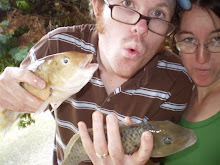Early Monday morning we were on the road heading south to Lake Naivasha. First stop was Crater Lake Reserve. After a drive around the crater walls, we stopped for lunch in the presence giraffes and black-and-white colobus monkeys. Down in the crater, a few flamingos fed at the edge of shore, whilst two fish eagles perched above looking for their next meal to surface. All around the edge of the lake there was evidence of buffalo. Thankfully we didn’t bump into them as we wondered around on the plains and the crater rim (we found out later that two people were killed last year by startling a buffalo with her calf). We did however get within 5 meters of a few giraffes and cute dik dik.
 |
| Black-and-white Colobus playing in the Acacia trees |
 |
| Crater Lake as viewed from the crater rim |
After our walk on the wild side we head to our campsite to set up before dark, stopping briefly at Lake Oledion along the way. This lake has become home for thousands of flamingos that are fleeing the increasingly toxic waters of Lake Nakuru. And best of all, it was free to visit. For the next two nights we camped on the edge of Lake Naivasha, with only an electric fence standing between us and night-grazing hippos.
 |
| Flog loads of flamingos |
 |
| Chapattis and vege stew for dins |
As you drive around Lake Naivasha you can’t help but notice the seemingly endless rows of hot houses. Flower growing is big business in this region, supplying flowers to all around the world. Before we left on our trip we watched a documentary called “A Blooming Business” (
http://www.youtube.com/watch?v=4cW_Zp6dnrQ) about the flower growing industry at Lake Naivasha. It’s sad that the industry that provides so much employment causes so much damage to the environment and workers because of greed.
 |
| The hot houses cover much of the lake front and are slowly draining the lake. |
We got up early the next morning to make the most of the cool morning. After chowing down our uji (a thin millet porridge) we loaded the landcruiser with two mountain bikes and head for Hell’s Gate National Park (named after the thermal activity in the region). Yesterday was the walking safari, now it was time for a cycling safari. We followed the Twiga (giraffe) Circuit through the open savannah. Giraffe, zebra and warthogs freely roamed around us – keeping a safe distance from the invading two-wheeled creatures. As glided down the side of a small hill, we startled a small herd of buffalo. We squeezed hard on our breaks, skidding as the buffalo charged across the road 10 meters in front of us. Hearts pounding, we waited until all the buffalo had scrambled away. Feeling safe I hopped of my bike to get a photo of the buffalo and bikes. However, just then a few buffalo started warning charges at us. Adrenaline pumping, we flew down the hill for 100 meters. The buffalo were happy with that distance and allowed us to take a few photos before we continued on our way. After 4 hours under the oppressive sun we were happy to give up the saddle.
 |
| Fresh-air safaris |
 |
| Buffalo's are no match for our bikes |
After lunch and a short rest at the campsite we went for a drive to other end of the National Park. On the way through a small town we came across a mob arresting a man accused of being a thief. This was the second time we had driven into such a frightening and unsettling event. With corruption rife amongst the police, locals often take matters into their own hands, sometimes beating, sometimes killing the accused. It is a very complex and foreign situation that is difficult for a westerner to comprehend and process. Thankfully(!?!), we didn’t observe a lynching, if indeed it did occur in this instance. I am certainly grateful that in NZ we have a police force we can trust.
Wednesday morning we packed up camp and set off for our next adventure on Mt Suswa.























